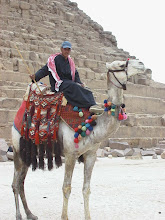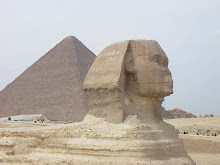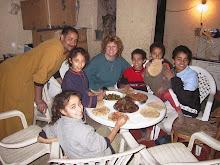March 8, 2005
Subject: resident tourist
What are the pyramids like? Have you seen the pyramids? When are you going to the pyramids? You haven't gone to the pyramids yet?!!!
This is the content of my inbox. I was beginning to feel ashamed of myself - all this way and I haven't even managed to get to the biggest attraction in all of Egypt - the pyramids - a mere 15 minute walk from my flat! How lazy have I been?
In my defense, I see the pyramids every day. I see them when I go up on my roof, I see them when I walk out the door of my apartment building, I see them coming down Faisal Street, my arms loaded with plastic bags full of fresh produce, yogurt and cookies from Bush Bush bakery. When I'm in my spare room, hanging my wet clothes on my drying rack, I can gaze out at Khufu (Cheops) - The Great Pyramid; and if I lean a little to the left (that's not a political confession!), I can see Khafre, the middle pyramid - the one that still has a bit of its limestone covering.
Seated up there on their plateau they impart solidity, power, and the ability to endure for all eternity. Guardians of the crowded, noisy city below, they seem to keep watch and to protect. The sight of them brings comfort and security as well as conveying a silent comment on man's desire for immortality; the massive stones a tease, hinting broadly at our potential to create whatever we seek.
And so yesterday I left my flat, and turned right outside my building - away from the lure of Faisal Street with it's shops and people and masses of cars which I find so entertaining - and I headed toward the pyramids. I stopped several times along the way to speak to people I know. Mahmoud, the cabbie and his buddies, who sit outside the five star hotels and promise good rates - don't believe them! - Mohammed who works in the perfume shop next to Karen's building, Kamal the aura reader, and the old guy who sits in his plastic chair just up the road a bit from Felfela. It was warm out, about 80, and humid, but overcast, with a breeze that ameliorated the dampness in the air.
I hiked up the hill, walking along the middle of the car-less street, following along behind a couple of other pyramid seekers, ignoring the calls of the vendors in the shops to my left. I pretty much knew where I was supposed to go - Karen had briefed me ahead of time - but still managed to let myself get sucked into the camel corral before I realized I'd turned too soon. Twenty steps in, wary of where I was, an eager camel jockey rapidly trying to work his sales magic on me, I realized my mistake and turned around. Three more guides followed me out the gate, shouting costs and trying to elicit my promise to return later for my camel ride. Shukran, shukran, no. I was on the verge of telling one particularly aggressive guy to "imshee" (back off, bud!), when I saw a military policeman walking toward us. The pest scuttled quickly, quietly back to his camel. A few more yards and I was accosted by a smooth-talking Egyptian, young and totally hot, this one, he sweet-talked me all the way up the hill. When my ego was full I laughed, thanked him profusely for his company (he was hoping to drum up business, of course) and waved him away.
I worked my way around the construction, and to the ticket booth. Next, a soft spoken young woman politely inspected my bag, and then I was in. There was a noticeable lack of tourists (I found out later from Karen that I got there between "shifts," groups of tourists who are shuttled up on buses). There was, however, a plethora of manned camels, horses and military police hanging about. To my left was the city, to my right the pyramids. It suddenly struck me as to where I was, and I looked up into the face of Khufu. I think I looked too fast, and I'm sure my mouth was hanging open. Yes, the pyramids are massive, amazing structures. Consciously we all know this, but standing at the foot of one I could FEEL it. A little intimidated, I turned toward my center of comfort - the city. I walked to the edge of the plateau where a small group of Italian women were taking photos of each other; Giza below providing their backdrop. Their laughter and their crazy, improbable tourist garb brought me back to Earth - tight, brightly patterned jeans, and ridiculous high heels, all with hair bleached too blonde. I stood gazing out over the city, collecting my thoughts, then turned back toward the pyramids to begin my exploration.
I will note here that a good portion of my day was spent fending off the camel guys, and the plastic pyramid pushers. It is a sad fact that most tourists leave Egypt with a negative impression of Egyptians. They think that all the inhabitants of this incredible city are on the make, and that baksheesh (money, tips) rules their lives. It's unfortunate that these shameless hustlers are so prevalent at all of the tourist locations. Vacationers return home thinking that all Egyptians are aggressive pests whose only interest is fleecing foreigners. For the record, it simply isn't true.
After gawking at the foot of Khufu for several long minutes, and making a note to myself to come back and climb up the face, where I could see other tourists milling about, I wandered over to Queen Hetepheres's tomb. I gazed into the 3'6" x 3'11" access hole built into the structure, and hesitantly gauged the steep angle descending blackly into the Earth. The guy sitting outside the tomb asked me if I wanted to go in - well, yeah! - "go in backward," he advised, "it's the best way." And so I entered my first ancient Egyptian tomb - butt first. I went down the ramp, which has been modified to include metal bars that act as steps to keep people from sliding ('il-haam-du lil-leh! praise be to God!). The climb seemed long, but I'm pretty certain that's because I was doubled over, backing down a steep ramp into unknown depths. I was struck by how warm and muggy it was down there - I was the only person there, so I couldn't blame it on body heat from sweaty, smelly tourists (myself aside!). I always imagined that the tombs would be a cool refuge from the desert heat. I was wrong. The room itself wasn't very big - maybe 12' x 12', but the ceiling was high, and of course all of the artifacts had been removed. The stones were massive, stacked one on top of another, all fitted perfectly together - not a chink in sight. I figured the slab directly across from the entrance was where the Queen's mummified body lay, waiting to rise again. Nothing more to see, I ran my hands over a few stones, stared up at the ceiling, then headed back up the ramp.
The Sphinx was next, my own personal favorite. I could see the top of its head, and I made a beeline for it, weaving my way through seemingly random ruins and past Khafre's pyramid, Khufu to my back. I found myself on a paved road, going down a hill, staring at the rear of the mighty Sphinx. I dallied on the way, stopping every now and again to stare, as the road wound its way around the Sphinx's complex. Down below I circled from every accessible angle. The best view was achieved by going through the temple and along the right side of the Sphinx where there is a long wall. The path along the wall takes you to the back of the Sphinx, where you can step up, then walk toward the front again, and stop at an elevated height where the head can be viewed clearly against the sky, with nothing but the great pyramids behind it. I found myself behind a young American man, a hippie-dippie Californian who was loudly telling his companion how he "felt the energy of the Sphinx" enter him. On the way back up the hill I was asked twice if I was "in-gi-lee-zee" (British). Why yes, yes I am in-gi-lee-zee. And I hurried on my way without saying anything else, before they could put a finer pin on my accent.
I went into the boat museum after that. In 1954 workers stumbled on the boat of Cheops, which had been buried next to his pyramid (Khufu). Had it not been for Karen's suggestion I would have eschewed the 35 LE fee to get in - an old boat, cool, I'll look it up on the internet. But I'm thrilled that I took the time and spent the pounds to see it. 4,600 years old, 43.40 metres long, it is constructed of cedar wood, held together only with rope - no nails. It required 20 oarsmen, and two more working as the rudder. It took nearly 30 years to restore. It is housed in its own temperature controlled building, and hangs suspended at the top of that building. There are stairs leading up to catwalks where it can be viewed straight on. I cannot convey the impressive aura of this boat. If you ever have the chance to see it, take it.
I did go into one of the big pyramids - Khafre. I bought my ticket and got in line. At this point the second "shift" of tourists had arrived, and there were a good number of people around. The entrance into the pyramid was just like the entrance into Queen Hetepheres's tomb, except that that little 3'6" x 3'11" tunnel that was descending down toward the center of the the Earth was accommodating two steady lines of bodies - those going in, and those coming out. There was no backing into this pyramid - I would have to go in forward, without the luxury of my earlier oneness. I followed the line of tourists - Spanish, Italians, Japanese, French - and in my turn doubled over, kissing my bent knees, and hunched my way into the tunnel with everyone else. Within ten seconds I wondered if I could do it. Pyramids are no place for semi-claustrophobes, and I could feel my lungs faltering as panic threatened to move in. The air was thick and hot, I couldn't stand up, I couldn't stretch to the side, I couldn't back up, and I couldn't see the end. I wondered briefly what would happen if we all got to the bottom, and the pyramid, after standing for thousands of years, finally gave up and collapsed. And then I came to my senses. So there I went with everyone else, face to butt, crabbing down the long tunnel, praying that the old German guy in front of me hadn't eaten fuul (beans) for lunch.
At the bottom we came out into a huge chamber, with high ceilings. A large Egyptian in a flowing white galabaya gave a speech about the room - rather short - "This is where the body of Khafre lay!" and he indicated a sarcophagus at the far side of the space. He repeated himself in several languages. I allowed myself to be herded over with the rest of the crowd, and looked dutifully into the empty stone box. Sights having been seen, I retreated to a relatively quiet corner and made an effort to appreciate where I was. And then I headed for that tiny little hole in the stone where I found myself with many other anxious individuals, all just as eager as I to get back up to the top.
Once out, we all breathed deeply, sucking in the cool fresh breeze that was thankfully passing by. We wiped sweat from our foreheads and grinned goofily at one another, then went our separate ways. I poked around the plateau awhile longer, sticking my nose into ancient doorways that seemed to lead nowhere, and peering down deep, deep holes, covered by grates to keep people from falling in. I ran my hands along stone walls, took photographs, fended off vendors and chatted with the camel jockeys that I wasn't able to shake right away. Sweaty, tired and sore, ready to go home, I made my last planned stop at Khufu's pyramid. I wanted to climb up the wall where earlier I'd seen the other tourists. I made my way up the first part of the stairway, stepping around the group of Eastern European women who were happily posing for photographs for their husbands on the ground. I continued to follow the steps up, until they stopped. There was an entrance to the pyramid, but it was closed. I was the only one there, so sat down on one of the stones, and looked out at the city of Giza. I was there less than a minute when I heard the shrill sounds of a whistle, and then, "get down!" I looked and a policeman was gesturing at me. Oops. I went down to the next level, and the guy met me there. I asked why I had to get down, "closed!" I suggested that he put up a barrier if he didn't want people there - I was embarrassed at having been chastised in front of a couple of hundred people. He didn't speak English. He smiled and nodded, so I smiled, forgiving him, and headed back down the pyraid as he rushed past me, blowing his little whistle, to stop two more unsuspecting tourists from going up the same stairway. Then I watched as he put up the barrier.
I walked once again, to the edge of the plateau, and stared down at the city. There was no one around me, and it was call to prayer. I stood there and listened as the multitude of mosques broadcast their individual offerings, all echoing up to where I stood - an oddly soothing cacophony that matched the landscape of hovels and high rises below.
Yesterday was my day to appreciate where I am, and the opportunities that are available to me. Like my hippie-dippie brethren at the Sphinx, I felt the energy of this place - its complexity, and its simplicity; that paradox that defines us all.
Subscribe to:
Post Comments (Atom)






No comments:
Post a Comment